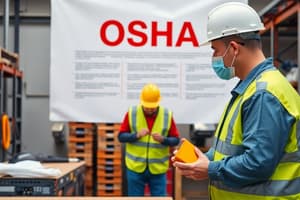Podcast
Questions and Answers
What does OSHA ensure that employees have the right to?
What does OSHA ensure that employees have the right to?
- Receive information and training on workplace hazards (correct)
- Work in unsafe environments
- Ignore safety protocols
- None of the above
Training is an important way to keep yourself and others safe while at work.
Training is an important way to keep yourself and others safe while at work.
True (A)
If you see an employee performing their job task in an unsafe way you should ___________
If you see an employee performing their job task in an unsafe way you should ___________
inform the employee it is unsafe and demonstrate how to do it safely.
Safety and environmental training is important in keeping employees safe and free from injuries and illness.
Safety and environmental training is important in keeping employees safe and free from injuries and illness.
Employees are not responsible for their own safety while at work.
Employees are not responsible for their own safety while at work.
There are some sections of the SDS that are not mandatory.
There are some sections of the SDS that are not mandatory.
What does the skull and crossbones pictogram indicate about a chemical?
What does the skull and crossbones pictogram indicate about a chemical?
A local reaction is when a chemical enters the bloodstream.
A local reaction is when a chemical enters the bloodstream.
What information must chemical manufacturers present on the product's label?
What information must chemical manufacturers present on the product's label?
The term route of entry on an SDS refers to the way a ____ enters the body.
The term route of entry on an SDS refers to the way a ____ enters the body.
Eating around chemicals in the workplace is considered safe because today's chemicals are more diluted than in the past.
Eating around chemicals in the workplace is considered safe because today's chemicals are more diluted than in the past.
The Hazard Communication Standard (HCS) is also known as the 'right to know' law.
The Hazard Communication Standard (HCS) is also known as the 'right to know' law.
Dust, dirt, or metal chips can pose a potential ____ injury risk in a shop.
Dust, dirt, or metal chips can pose a potential ____ injury risk in a shop.
_________ gloves are made from a synthetic rubber and provide protection from a variety of chemicals such as peroxide and highly corrosive acids.
_________ gloves are made from a synthetic rubber and provide protection from a variety of chemicals such as peroxide and highly corrosive acids.
If your PPE doesn't fit properly or needs repair, you should continue to wear it until your employer gets around to buying new PPE.
If your PPE doesn't fit properly or needs repair, you should continue to wear it until your employer gets around to buying new PPE.
These are examples of foot and leg protection:
These are examples of foot and leg protection:
_________ are a tight-fitting form of PPE that covers the eyes and provides protection from impact, dust, and splashes.
_________ are a tight-fitting form of PPE that covers the eyes and provides protection from impact, dust, and splashes.
Single-use earplugs require a professional fitting before they can be used.
Single-use earplugs require a professional fitting before they can be used.
____________ help protect the lower legs and feet from heat hazards like molten metal and welding sparks.
____________ help protect the lower legs and feet from heat hazards like molten metal and welding sparks.
Engineering controls are the physical changes that employers make to the work environment or to equipment that make it safer to use.
Engineering controls are the physical changes that employers make to the work environment or to equipment that make it safer to use.
The proper use of Personal Protective Equipment (PPE) helps prevent workplace injuries.
The proper use of Personal Protective Equipment (PPE) helps prevent workplace injuries.
Respirators should be worn when there is hazardous air pollution in the workplace.
Respirators should be worn when there is hazardous air pollution in the workplace.
This can change the fit of your respirator.
This can change the fit of your respirator.
A negative pressure respirator brings fresh air to you through a hose.
A negative pressure respirator brings fresh air to you through a hose.
It is always the employee's responsibility to make sure they wear their respirator.
It is always the employee's responsibility to make sure they wear their respirator.
When choosing a respirator for your job, you must conduct a _____ test.
When choosing a respirator for your job, you must conduct a _____ test.
___________ poses the greatest risk to workers because it is more common and more easily transmitted than other bloodborne diseases.
___________ poses the greatest risk to workers because it is more common and more easily transmitted than other bloodborne diseases.
Employees should use a disinfectant when cleaning up a surface contaminated by blood.
Employees should use a disinfectant when cleaning up a surface contaminated by blood.
Workers can be exposed to blood or other potentially infectious materials (OPIM) if it splashes into their _____.
Workers can be exposed to blood or other potentially infectious materials (OPIM) if it splashes into their _____.
If wearing protective gloves, there's no need to wash your hands after exposure to blood.
If wearing protective gloves, there's no need to wash your hands after exposure to blood.
Coming into contact with another person's blood increases your chances of contracting a disease.
Coming into contact with another person's blood increases your chances of contracting a disease.
Only __________ should perform CPR on an accident victim.
Only __________ should perform CPR on an accident victim.
A second-degree burn may develop blisters.
A second-degree burn may develop blisters.
Flashcards are hidden until you start studying
Study Notes
Workplace Safety Overview
- OSHA (Occupational Safety and Health Administration) mandates that employees receive training concerning workplace hazards.
- Training is essential for ensuring safety for oneself and coworkers.
- Employees are responsible for their own safety and should recognize unsafe practices in the workplace.
Safety Training and Standards
- Safety and environmental training is crucial for preventing injuries and illnesses.
- The Hazard Communication Standard (HCS), also termed the "right to know" law, obligates chemical manufacturers to provide critical safety information on labels.
- Some sections of Safety Data Sheets (SDS) are non-mandatory, but essential information must still be presented.
Personal Protective Equipment (PPE)
- Goggles are recommended for eye protection against impacts, dust, and splashes.
- PPE must fit properly; if it does not, it should not be worn until repaired or replaced.
- Employees must ensure they wear respirators when required, and proper fit tests must be conducted.
Chemical Safety
- Acute toxicity is indicated by the skull and crossbones pictogram on chemical labels.
- Eating around workplace chemicals is unsafe regardless of dilution levels.
- It is incorrect to state that a local reaction involves chemicals entering the bloodstream.
Workplace Hazards
- Common workplace hazards include dust, dirt, or metal chips posing eye injury risks.
- Engineering controls modify the work environment to enhance safety.
- Disinfectants should be used for cleaning surfaces contaminated with blood or potentially infectious materials.
Bloodborne Pathogens and Infection Control
- Hepatitis B Virus (HBV) presents a significant risk due to its commonality and ease of transmission.
- Contact with another person's blood heightens the risk of disease transmission.
- Hand hygiene is necessary even when wearing protective gloves after exposure to blood.
Emergency Preparedness
- CPR can only be performed by individuals certified in the procedure.
- A second-degree burn is characterized by the development of blisters, indicating skin damage.
Quizzes and Module Remarks
- Various modules include quizzes assessing understanding of safety protocols, PPE usage, and handling of hazardous materials.
- Continuous assessment is essential for retaining knowledge on workplace safety practices.
Studying That Suits You
Use AI to generate personalized quizzes and flashcards to suit your learning preferences.




